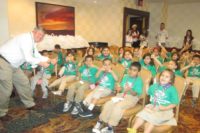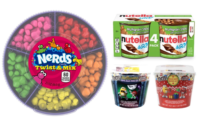![]()
The Wild Child
Novelty candy is not supposed to be proper or predictable
— so go wacky with this one.
It should come as no surprise that non-chocolate candy
makes up the core of the novelty confection section — the ratio of
non-chocolate to chocolate items in the category is about 23 to 1.
Obviously, the durability and flexibility of non-chocolate far surpasses
the delicate nature of chocolate for candy with “toyetic”
purposes.
For 2003, both versions of novelty were flat. Non-chocolate
was down ever so slightly in dollar sales (1.3 percent over the prior year),
and chocolate was down almost 6 percent. This was disappointing after novelty
really seemed to come alive for non-chocolate in 2001, and for chocolate in
2002 (That year, novelty chocolate was up in dollar sales more than 60 percent).
Currently, the category is certainly holding its own, but continual innovation
and excitement are not being maxed out at the retail level. Perhaps vendors
and retailers should be having a little more fun with it.
The Imperatives
Retailers should view this category as an opportunity
to bring innovation to the candy aisles. But innovation here is often
described as being outrageous, outlandish, wild, wacky, and even disgusting
and gross. Buyers need to connect on a kid’s level if they want to
truly capture the opportunity in sales. Kids are continually going to look
for the new and unusual in this category, not their favorite nationally
branded product. The very nature of novelty is that it includes little
items that have never been seen before — anywhere. This
provides a retailer the opportunity to take a little more risk — and
to possibly be among the first to carry the next successful novelty
product. The common pitfall for retailers is failing to keep the item
selection in this category constantly novel.
Consumers
Kids are anything but brand loyal in the category
— and in this case, that’s okay. Pre-teens and early teens make
up much of the target audience, and to them — value or value
impression of the products is the most important factor.
Experts say that the most successful products now
marketed to kids are those that have “kid drivers” in them.
That could mean it leverages a kid’s need for control, as in buying
something that parents would find totally repulsive or crazy. It lets kids
be kids, and in that, they will perceive true kid value.
The drawback is, they’re not inspired by the same “novel”
product for too long. Retailers who want to play and merchandise their stores
with this category will need to stay culturally in tune with what’s cool
to the various age levels of kids. Kids are fickle, and they move fast here.
Marketing
The category is getting more competitive than ever
— something the savvy retailer can use to its advantage.
Manufacturers are trying super hard to pack as much value in their new
items as possible, giving retailers more room for potential profit margin.
What’s more, the acceptable price level of “a
really cool candy” has gone up from 99 cents and below to $1.49 -$1.99,
report novelty candy marketers who just keep raising the bar on value. Especially
with regard to convenience stores, which have a higher margin than mass, $1.49
is a perfectly acceptable price point in the category, and for that, they can
provide a much more fun product than they could when the price point was below
a dollar.
Outlook
The category is expected to grow as more kids secure more disposable
income. But the prediction is that they will still want everything they
can get for that dollar — as they get even more savvy in finances and
price-comparison, thanks to the internet, and will know more in terms of what
a dollar can and should buy. This should keep the category on its wild and wacky
toes.
Merchandising Musts
Position novelty products at eye level for kids.
These products belong on the lower shelves. Its not just that they are marketed to kids many other candies are too, of course. Its more that the outrageous nature of this candy deserves front and center attention and will serve as the most exciting focal point of the entire section. Remember: These kid customers will later be your teen and adult customers, so its best to wow them now.
Multiple placement is a must.
To kids, this is the most impulsive candy category around because items are often viewed as "little toys that come with candy." Multiple placements in toy and game aisles can generate truly incremental sales, and they are, therefore, a "must," and not a "might" for forward-thinking retailers. The items cross-merchandise well in the toy sections because customers are in a similar buying mindset and that goes for kids shopping for themselves or for friends or parents shopping for kids. Near school supplies is also an ideal spot during the heavy kid foot traffic of the Back-to-School selling season. Most novelty manufacturers are prepared for this with power wing and floor displays of their most popular items making in and out placement easy for retailers.
Merchandising Musts
Position novelty products at eye level for kids.
These products belong on the lower shelves. Its not just that they are marketed to kids many other candies are too, of course. Its more that the outrageous nature of this candy deserves front and center attention and will serve as the most exciting focal point of the entire section. Remember: These kid customers will later be your teen and adult customers, so its best to wow them now.
Multiple placement is a must.
To kids, this is the most impulsive candy category around because items are often viewed as "little toys that come with candy." Multiple placements in toy and game aisles can generate truly incremental sales, and they are, therefore, a "must," and not a "might" for forward-thinking retailers. The items cross-merchandise well in the toy sections because customers are in a similar buying mindset and that goes for kids shopping for themselves or for friends or parents shopping for kids. Near school supplies is also an ideal spot during the heavy kid foot traffic of the Back-to-School selling season. Most novelty manufacturers are prepared for this with power wing and floor displays of their most popular items making in and out placement easy for retailers.


